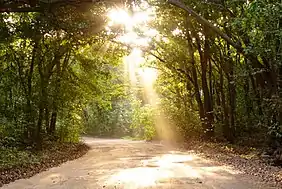Restinga de Cabedelo National Forest
The Restinga de Cabedelo National Forest (Portuguese: Floresta Nacional da Restinga de Cabedelo) is a national forest in the state of Paraíba, Brazil.
| Restinga de Cabedelo National Forest | |
|---|---|
| Floresta Nacional da Restinga de Cabedelo | |
IUCN category VI (protected area with sustainable use of natural resources) | |
 Access road to the forest | |
 | |
| Nearest city | Cabedelo, Paraíba |
| Coordinates | 7°03′51″S 34°51′19″W |
| Area | 114.34 ha (282.5 acres) |
| Designation | National forest |
| Created | 2 June 2004 |
| Administrator | ICMBio |
Location
The Restinga de Cabedelo National Forest is divided between the municipalities of Cabedelo (79%) and João Pessoa (215) in the state of Paraíba. It has an area of 114.34 hectares (282.5 acres).[1][lower-alpha 1] It is in the João Pessoa metropolitan region. The conservation unit is popularly called the AMEM Forest. It is administered by the federal Chico Mendes Institute for Biodiversity Conservation (ICMBio).[4]
History
The Restinga de Cabedelo National Forest was created by federal decree on 2 June 2004 with an area of 103 hectares (250 acres). It is classed as IUCN protected area category VI (protected area with sustainable use of natural resources). The purpose is sustainable use of forest resources, and scientific research with emphasis on methods for sustainable exploitation of native forests.[2] By ordinance 11 of 16 March 2009 the president of ICMBio created the consultative council, with the goal of helping to create and implement the management plan. The management plan was approved by ordinance 76 of 13 February 2017.[5]
Environment
The Restinga de Cabedelo National Forest holds one of the last fragments of Atlantic Forest restinga vegetation in Paraíba.[4] Vegetation includes Atlantic forest with areas of mangrove, restinga fields and restinga forest.[1]
Public use
In 2000 it was reported that the people of the adjoining Renascer bairro often used the forest for fruit, firewood, herbs and plants for food and medicine.[6] 32 research projects were authorized between 2008 and 2013. Due to low staff levels, the forest has not been used for educational purposes. There are no facilities for visitors such as a visitor center, shops and cafeteria.[6] There is an auditorium for 50 people, accessible bathrooms and covered parking.[7]
Problems include illegal fishing, practice of religious rituals, drug use, theft and other crimes. Conflicting uses include the AMEM shelter for the elderly, wild animal screening center, and the highway, railway, gas pipeline and electrical power lines that adjoins or cross the forest.[7]
Notes
Sources
- Flona da Restinga de Cabedelo (in Portuguese), ICMBio, retrieved 2016-03-23
- FLONA da Restinga de Cabedelo (in Portuguese), ISA: Instituto Socioambiental, retrieved 2017-03-22
- Flona de Cabedelo (in Portuguese), ICMBio: Chico Mendes Institute for Biodiversity Conservation, retrieved 2017-03-23
- Goncalves, Augusta Rosa; Fernandes, Carlos Henrique Velasquez (December 2016), Plano de Manejo da Floresta Nacional da Restinga de Cabedelo (PDF) (in Portuguese), Cabedelo: ICMBio, retrieved 2017-03-23
- Unidade de Conservação: Floresta Nacional da Restinga de Cabedelo (in Portuguese), MMA: Ministério do Meio Ambiente, retrieved 2017-03-23